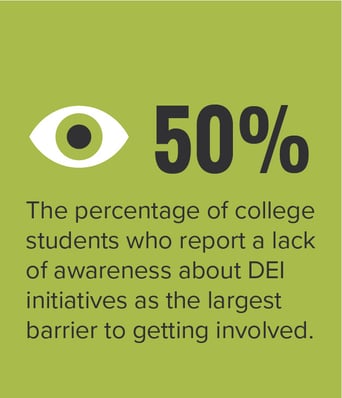Diversity, equity and inclusion (DEI) go way beyond having a diversity office on campus or a statement on a college website. Recognizing and sincerely welcoming the differences of each person is critical to recruiting and retaining students in higher education.
Let's start by defining each piece of DEI:
Diversity - The presence of differences that may include race, gender, religion, sexual orientation, ethnicity, nationality, socioeconomic status, language, (dis)ability, age, etc.
Equity - Promoting justice, impartiality and fairness within the procedures, processes and distribution of resources by institutions or systems.
Inclusion - An outcome that ensures those with differences actually feel and/or are sincerely welcomed.
Most everyone can agree that DEI initiatives are a critical component of a college or university's plan to provide safe learning spaces for historically underserved students. Commitment and true change for DEI initiatives take time and resources.
Diversity is most often times the part of the DEI equation that people "see," and inclusion lends the voice. It is important that all three components are present and work together for the initiatives to be authentic.
When a warm and sincere welcome is extended to invite people into your space, that is when inclusion has been achieved. This space is nurtured, fostered and promoted as a safe place for all to gather, belong and learn from each other. Students spend anywhere from 6-18 hours a week in the physical classroom. DEI brings a classroom to every space on campus for the remaining 150 hours of the week.

Measurable Results
The journey for policy change is long and requires resources of time and people. Keep in mind "who is benefited by this policy?" and "who is burdened by this policy?" Leading inclusively gives the direction for everyone that DEI is important and is at the forethought of every decision and action.
Measuring and demonstrating results toward reaching DEI goals will be necessary to be accountable for larger change. Use data to understand current gaps in campus equity, measure baselines and track the progress of DEI initiatives. DEI offices and groups will need to work with current students for qualitative feedback to make sure initiatives are appropriate and responsive to students' needs.
DEI is much more than a department. It's in the very ecosystem of your campus. Each person who gets involved in a diverse and inclusive space becomes a student, a teacher and is heard. We all teach and learn from each other. Differences are not only recognized but also are the very thing that makes each of us a valuable contributor.
Making sure you are demonstrating diversity isn't something to worry about - it should come naturally. Every decision should return to asking yourself, "What are we trying to do here?" and "How does this fit with our mission?" You need each piece - diversity, equity and inclusion - to be authentic in your actions.
Being open to learning about all the characteristics that make up the differences, not just cultural, between people is necessary to give everyone an opportunity to be understood and represented. It's the very heart of inclusivity.
So how do you show DEI?
You have to know yourself and your institution to be able to engage in acts of inclusion. Be intentional and your efforts must be sustainable. Avoid tokenism, which is the placement of a few individuals to represent a whole. This devalues the individual. They feel the insincerity and so will your audience.
DEI isn't just about your student body or a club on campus; it encompasses your institution as a whole.
- Showcase diverse and inclusive learning environments and methods.
- Feature inclusive workspaces, living spaces, etc.
- Demonstrate learning accommodations.
- Ask for and amplify student experience stories with intentionality toward DEI.
- Highlight cultural and social events as learning opportunities, not as an exhibition.
It must be said again - avoid tokenism. Be sincere and authentic. Strive for inclusive excellence in all executions, no matter how small.



-1.png?width=290&name=Untitled%20design%20(2)-1.png)